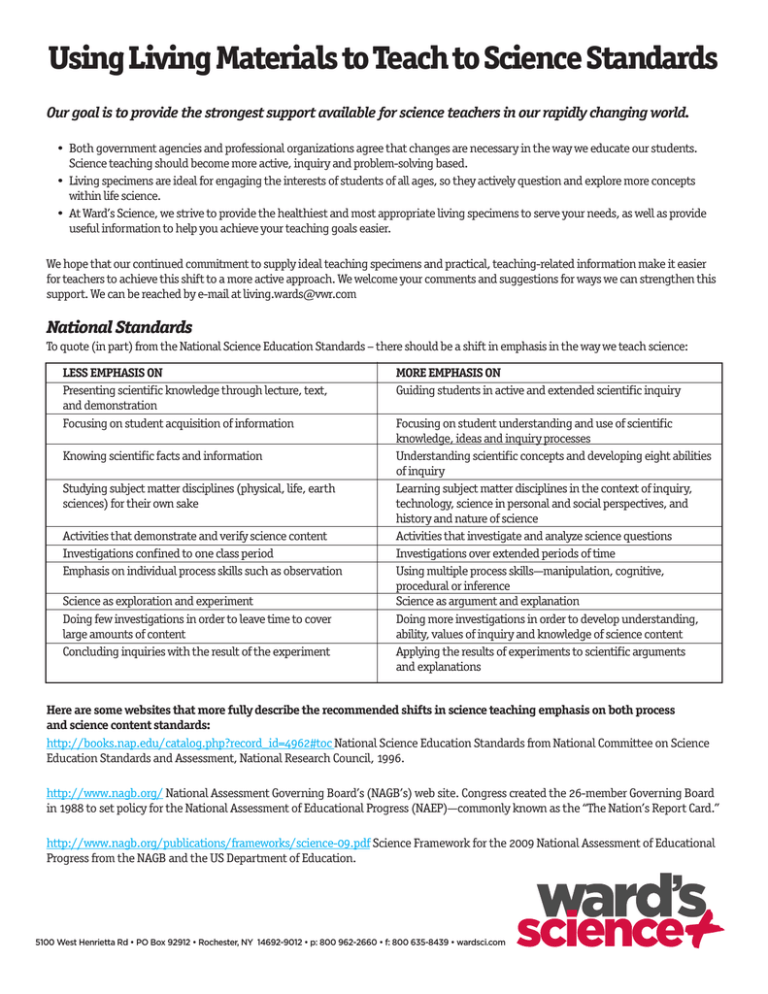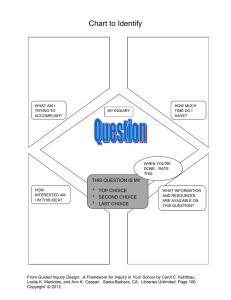
Using Living Materials to Teach to Science Standards
Our goal is to provide the strongest support available for science teachers in our rapidly changing world.
• Both government agencies and professional organizations agree that changes are necessary in the way we educate our students.
Science teaching should become more active, inquiry and problem-solving based.
• Living specimens are ideal for engaging the interests of students of all ages, so they actively question and explore more concepts
within life science.
• At Ward’s Science, we strive to provide the healthiest and most appropriate living specimens to serve your needs, as well as provide
useful information to help you achieve your teaching goals easier.
We hope that our continued commitment to supply ideal teaching specimens and practical, teaching-related information make it easier
for teachers to achieve this shift to a more active approach. We welcome your comments and suggestions for ways we can strengthen this
support. We can be reached by e-mail at living.wards@vwr.com
National Standards
To quote (in part) from the National Science Education Standards – there should be a shift in emphasis in the way we teach science:
LESS EMPHASIS ON
Presenting scientific knowledge through lecture, text,
and demonstration
Focusing on student acquisition of information
Knowing scientific facts and information
Studying subject matter disciplines (physical, life, earth
sciences) for their own sake
Activities that demonstrate and verify science content
Investigations confined to one class period
Emphasis on individual process skills such as observation
Science as exploration and experiment
Doing few investigations in order to leave time to cover
large amounts of content
Concluding inquiries with the result of the experiment
MORE EMPHASIS ON
Guiding students in active and extended scientific inquiry
Focusing on student understanding and use of scientific
knowledge, ideas and inquiry processes
Understanding scientific concepts and developing eight abilities
of inquiry
Learning subject matter disciplines in the context of inquiry,
technology, science in personal and social perspectives, and
history and nature of science
Activities that investigate and analyze science questions
Investigations over extended periods of time
Using multiple process skills—manipulation, cognitive,
procedural or inference
Science as argument and explanation
Doing more investigations in order to develop understanding,
ability, values of inquiry and knowledge of science content
Applying the results of experiments to scientific arguments
and explanations
Here are some websites that more fully describe the recommended shifts in science teaching emphasis on both process
and science content standards:
http://books.nap.edu/catalog.php?record_id=4962#toc National Science Education Standards from National Committee on Science
Education Standards and Assessment, National Research Council, 1996.
http://www.nagb.org/ National Assessment Governing Board’s (NAGB’s) web site. Congress created the 26-member Governing Board
in 1988 to set policy for the National Assessment of Educational Progress (NAEP)—commonly known as the “The Nation’s Report Card.”
http://www.nagb.org/publications/frameworks/science-09.pdf Science Framework for the 2009 National Assessment of Educational
Progress from the NAGB and the US Department of Education.
8FTU )FOSJFUUB 3E t 10 #PY t 3PDIFTUFS /: t Q t G t XBSETDJDPN
http://www.project2061.org/publications/sfaa/online/sfaatoc.htm Project 2061’s 1989 publication, Science for All Americans.
Science for All Americans defines science literacy and lays out some principles for effective learning and teaching. From the American
Association for the Advancement of Science (AAAS).
State-specific standards can be found online using the search terms: “state science teaching standards education” in most search
engines (Google, etc.).
A short summary of the General Content Standards for different grade levels is reproduced from the National Science Education
Standards below. We have reproduced grade level detail in topics related to life science that would benefit from the use of living
organisms in classroom activities.
ALL GRADES
SCIENCE AS INQUIRY
Abilities necessary to do
scientific inquiry
Understandings about
scientific inquiry
Grades K–4
LIFE SCIENCE
Characteristics of organisms
Life cycles of organisms
Organisms and environments
UNIFYING CONCEPTS
AND PROCESSES
Systems, order, and organization
Evidence, models, and explanation
Change, constancy, and measurement
Evolution and equilibrium
Form and function
HISTORY AND NATURE OF SCIENCE
EARTH AND SPACE SCIENCE
PHYSICAL SCIENCE
SCIENCE IN PERSONAL
& SOCIAL PERSPECTIVES
Personal health
Characteristics and
changes in populations
Types of resources
Changes in environments
Science and technology
in local challenges
Grades 5–8
LIFE SCIENCE
Structure and function in
living systems
Reproduction and heredity
Grades 9–12
LIFE SCIENCE
The cell
Molecular basis
of heredity
Regulation and behavior
Biological evolution
Populations and ecosystems Interdependence
of organisms
Diversity and adaptations
Matter, energy, and
of organisms
organization in living
systems
Behavior of organisms
SCIENCE IN PERSONAL
SCIENCE IN PERSONAL
& SOCIAL PERSPECTIVES
& SOCIAL PERSPECTIVES
Personal health
Personal and
community health
Populations, resources,
Population growth
and environments
Natural hazards
Natural resources
Risks and benefits
Environmental quality
Science and technology
Natural and
in society
human-induced hazards
Science and technology
in local, national, and
global challenges
Science as Inquiry
The “Science as Inquiry” standard is often found confusing. To quote from the National Science Education Standards: “Students at all
grade levels and in every domain of science should have the opportunity to use scientific inquiry and develop the ability to think and
act in ways associated with inquiry, including
• asking questions,
• planning and conducting investigations,
• using appropriate tools and techniques to gather data,
• thinking critically and logically about relationships between evidence and explanations,
• constructing and analyzing alternative explanations,
• and communicating scientific arguments.”
8FTU )FOSJFUUB 3E t 10 #PY t 3PDIFTUFS /: t Q t G t XBSETDJDPN
Many groups have varying definitions of what inquiry-based teaching means (see
http://www.aaas.org/programs/education/about_ehr/pubs/inquiry.shtml and
http://www.nwrel.org/msec/science_inq/index.php). In general, inquiry is an approach that shifts more of the responsibility for
investigations from teachers to students, thereby making the students more active participants in their own education. Inquiry-based
teaching does not require choosing just one approach.
“Structured inquiry” is similar to traditional teaching methods that use hands-on demonstration activities that are planned and
directed by the teacher. In “Guided inquiry,” the question is framed by the teacher, but students have more responsibility for conducting investigations as well as critically thinking about evidence and explanations, with more limited input from the teacher. In “Open
Inquiry,” the teacher’s role is more as a facilitator, with the students taking responsibility for all levels of inquiry including framing a
question, designing and executing investigations, and scientifically defending an explanation. Most teachers prefer to tailor a mix of
the above styles of inquiry to their specific classroom situation. For example, earlier grade-level teachers tend to teach the majority of
lessons using more structured inquiry methods and mix in a few guided inquiry style lessons. Later grade-level teachers may utilize
more guided inquiry lessons and then facilitate one or two open inquiry projects.
Guided inquiry covers a large range of teacher involvement, but the teacher’s role is largely to get an investigation moving towards a
learning target and to make sure that students do not reinforce their own misinterpretations of any evidence. Teachers answer fewer
questions, and instead they ask questions to help lead students down the most valid interpretive path. This contains a large element
of the classic Socratic teaching method and provides a model for students of how to focus and generate relevant questions. However,
it also creates opportunities for teachers to answer questions and provide factual, content-based information in a context where it is
useful (and therefore meaningful and memorable) to the student for problem solving. Many traditional, structured classroom activities
can be modified to be taught in a more guided inquiry fashion. The easiest way to do this is to re-frame a demonstration activity as a
problem to be solved.
Ideas for classroom activities can be found in many places, but here is our short list of favorite sites with free
teaching resources:
http://www.free.ed.gov/?sid=8
Federal resources for educational excellence
http://www.nsf.gov/news/classroom/biology.jsp
National science foundation biology classroom resources
http://nsdl.org/
National science digital library
Science net links—lessons, tools, and resources aligned with project
http://www.sciencenetlinks.com/
2061 grade level benchmarks—Maintained by AAAS
http://www.biosciednet.org/portal/
BioEdNet—Resources for Biology Teaching —Maintained by AAAS
http://www.nsta.org/
National Science teachers association (NSTA)
National Association of Biology Teachers (NABT) instructional materials
http://www.nabt.org/
Howard Hughes Medical Institute site for free teaching resources
http://www.hhmi.org/biointeractive/
including virtual labs and animations.
Ward’s Science is committed to supplying high quality specimens and creative learning supplies to support the wide variety of classroom activities that teachers may wish to use. Many of our kits and activities include all the classroom materials you need to lead students in hands-on activities, including problem-solving. Each experiment and demonstration can also be easily adapted to the various
types of inquiry. For the full collection of our lab activities and kits for all sciences, look online or call to request our most recent catalog.
The simple introduction of living organisms into the classroom is an excellent way of engaging students in active exploration of life
science learning goals. The organisms stimulate students to ask questions and initiate investigations that test biological concepts in a
standard, guided, or open-inquiry teaching setting.
8FTU )FOSJFUUB 3E t 10 #PY t 3PDIFTUFS /: t Q t G t XBSETDJDPN
Living Organisims—Where to Find the Information You Need
Care sheets – Practical and Standards-Based Information
We have provided simple, standardized care sheets to help teachers:
• Select the most appropriate organisms to engage students of different skill levels in actively reaching the standard learning goals.
• Practically plan for the receipt and care of their selected organisms.
• Have all the information they need for a basic understanding of the organism, as well as information that helps explain possible
relationships between the organism and teaching standards.
Each care sheet should list:
• Common Name of Organism: To place the organism in context of previous knowledge and experience
• Scientific name/classification: To address Standards - Unified concepts – systems order and organization
• Conditions of ownership: Practical information related to USDA permit requirements
• Primary Hazard Conditions: To determine if your students can safely handle the organism
• Availability: Learn details of the availability of organisms, links to on-line ordering information, what to expect and how to
handle organisms when you receive them
• Captive Care: Guidelines on preparing for the needs of the organisms - classroom habitat, food and water
• Background Information: Facts related to standard teaching goals that can include:
• Method of reproduction
• Standards - Reproduction and heredity
• Determining sex (if applicable)
• Standards: Characteristics of Organisms, Unifying Concepts—Evolution, Structure and function, behavior
• Life cycle/Span
• Standards – life cycles, diversity and adaptation
• Wild habitat
• Standards: organisms and environments, resources, ecosystems
• Special Notes: Additional information that may relate to other standards, such as behavior, natural resources, etc.
• Disposition after class use: Suggestions about what to do with the organism after completion of classroom study
Many care sheet pages will be followed by a secondary piece of literature. This literature provides more detailed about the organisms
and their long-term care. We will be continually updating and expanding our live material care guides, to make this the easiest to use
and most current reference for teaching life science in an active, inquiry-based setting.
In addition to this resource, our Live Material Technicians, who contributed to the writing of this resource, are available to answer customer questions and offer help with any problems related to our live materials. Our Live Materials team can be most easily reached by
e-mailing living.wards@vwr.com. They can also be reached by calling our Customer Service desk at 800-962-2660 during regular business hours.
Thank you for choosing Ward’s Science as your source for quality live materials.
© 2008 Ward’ s Science. All rights reserved. Rev. 9/08, 11/09, 3/13
8FTU )FOSJFUUB 3E t 10 #PY t 3PDIFTUFS /: t Q t G t XBSETDJDPN

